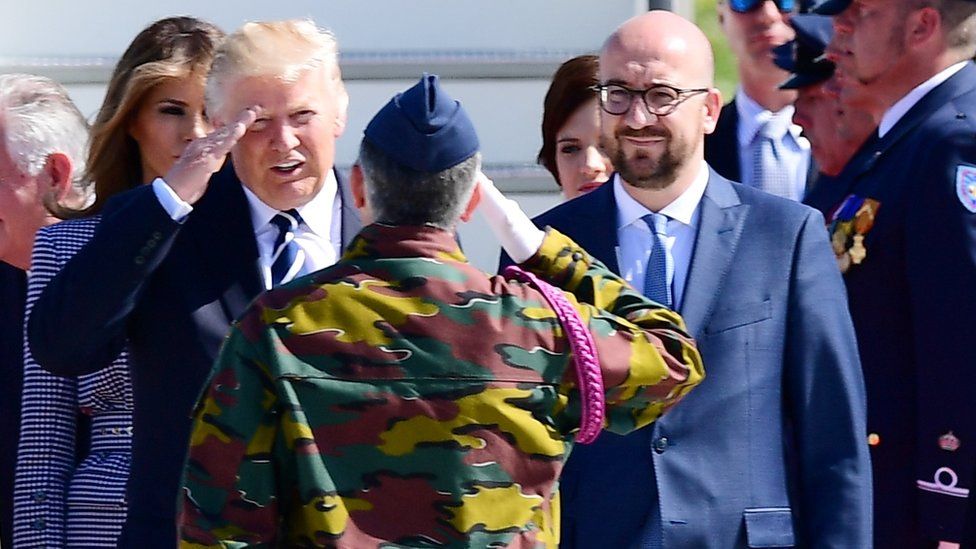Nato and Trump: What future for the Atlantic alliance?
- Published

This is like no other Nato summit, but then there has been no other US president quite like Donald Trump.
Never has there been a man in the White House - commander-in-chief of the most powerful military player in the alliance - who, at least on the campaign trail, described the organisation as "obsolete".
Mr Trump - unlike his predecessors - is not a man steeped in the orthodoxy of the trans-Atlantic partnership. He may now have reversed his position on Nato's obsolescence, but he tends to see things in transactional terms and it's clear that he still wonders if the US is getting a good deal from its Nato partners.
Indeed Nato officials are playing down any use of the term "summit" at all. I understand that Nato Secretary General Jens Stoltenberg is seeking a proper, full-scale summit in 2018.
This Brussels meeting is a brief affair; in large part a ceremonial occasion with a dinner attached. Two monuments will be unveiled and a ribbon will be cut marking the opening of the as-yet-unfinished new Nato headquarters.
"It's all a bit unscripted and very light on substance," commented one Nato insider. "It's all about creating an atmosphere - hopefully we will get a couple of good presidential tweets."
For all the uncertainties about President Trump's position, in many ways the Atlantic alliance is in good health:
- Its Afghan advise-and-assist mission continues, underscoring its role in stabilisation and counter-terrorism
- It has despatched a small number of military units to its eastern flank to reassure the nervous Baltic States and Poland, who fear further Russian land-grabs after the annexation of Crimea from Ukraine
- US tanks are back in Western Europe, adding to the deterrent effect
- It is still taking in members - Montenegro will be present at this leaders' meeting for the first time, though it only formally joins the alliance in June
- In public opinion terms, positive opinions about Nato are on the rise in Alliance countries, according to a recent opinion poll by the Pew Research Center
But the shiny and unfinished new headquarters building is a kind of metaphor for the state of the alliance as a whole.
All appearances are of vitality and unquestioned relevance: an alliance capable of carrying out old missions like deterring against a resurgent Russian threat while grappling with the new - instability, terrorism and cyber-war.
Big questions facing Nato's leaders
Beneath the surface there is still a good deal of unfinished business and uncertainty about the way ahead.
There are arguments about resources and future missions; there are fissures opening up between members; and fundamental questions as to whether many of the "new" security challenges really fall within the remit of Nato at all.
Resources have taken up much of the limelight - not least because Mr Trump, like every recent president before him, insists that Washington's allies must spend more.
The alliance has anchored itself to the benchmark goal that 2% of a country's GDP should go on defence spending. A few are already there. Some are on the way to this goal; many are certainly spending more.
But there are still huge doubts as to how far this is really generating additional military capability at a time when technology is changing quickly and the need for rapidly deployable forces is growing.
Will Nato take on a big role against IS?
Washington wants Nato to be even more involved in counter-terrorism and the struggle against so-called Islamic State.
Nato does a lot of work with partners on building defence capacity and reforming security structures. It has helped with training in Iraq and Jordan and so on.
But the Americans want Nato to join the anti-IS coalition as Nato: most of its members already have seats at the table. The plan seems likely to go ahead with Nato advance warning and control systems and tanker aircraft playing a more active role in the air campaign.
At least at the European end of the alliance, there is a fear in some quarters as to where this may all lead. Could Nato allies become embroiled in a post-conflict Iraq or indeed in Libya, just as they appear stuck in Afghanistan?
Challenges and differences facing Nato
At root, though, there is another problem.
Many of the "new" challenges - cyber; the Russian disinformation campaign waged against Western societies; "grey-zone" warfare combining elements of both, along with military power (as seen in Ukraine) - are not entirely or even exclusively the remit of a military or diplomatic organisation.
There is a military dimension of course, but these are as much matters of civil resilience for private industry and institutions as they are for government.
Nato does not have a central role.
There are also internal strains within the alliance. The broad difference in emphasis has been managed up to now between northern member-states, whose chief worry is Russia, and those in the south, on Nato's Mediterranean coast, who see the wider instability in the Middle East as the prime threat.
But Turkey's drift towards authoritarianism and its flirtation with Russia warn of potential problems ahead on the alliance's southern flank.
Nato clearly still has a role both as a diplomatic forum and as a provider of military punch when needed.
But huge questions still remain about its capacity, enthusiasm and appetite for effective nation-building in conflict zones; a problem, in fairness, that all major international institutions are grappling with.